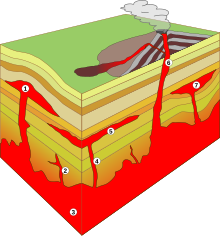Intrusion (geology)

In geology, intrusion generally refers to the penetration of flowable material into existing rock bodies (e.g. also from salt domes or soft clays into the overlying layers).
As a rule, however, the term refers to the penetration of molten magma and also, in a somewhat fuzzy manner, to the rock bodies formed in this way. The igneous rocks that crystallize out during the solidification of magmas within the earth's crust are therefore also referred to as intrusives or intrusive rocks . Depending on the depth in relation to the land surface at the time of the intrusion, a distinction is made between deep rocks ( plutonites , see also pluton ), which solidified at a relatively great depth, and dike rocks (sub-volcanic rocks ; see also cryptovolcanism ), which solidified at a relatively shallow depth. In the case of sub-volcanic intrusions, different types are distinguished depending on their shape and spatial location ( chimney , sill , dyke , laccolith , lopolith ).
See also
literature
- Hans Murawski: Geological Dictionary . 8th edition. Ferdinand Enke, Stuttgart 1982, ISBN 3-432-84108-6 .
